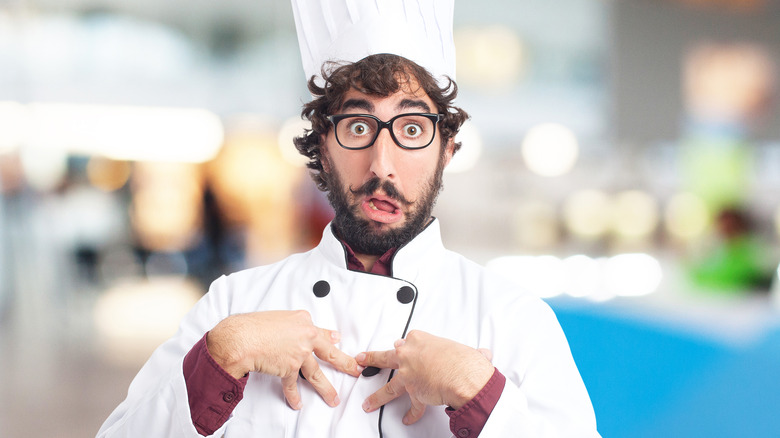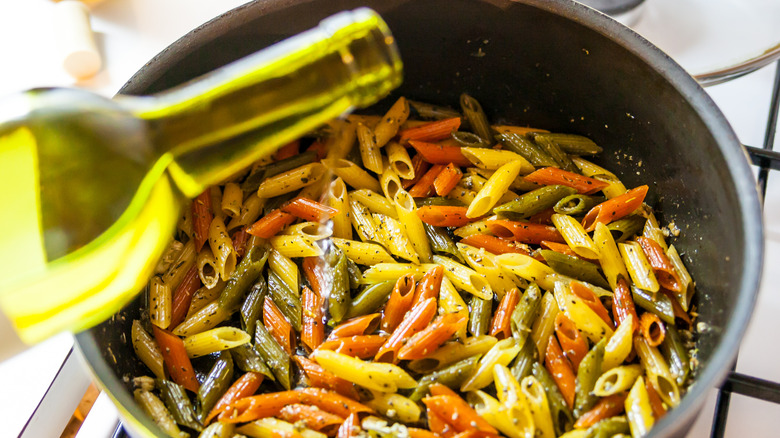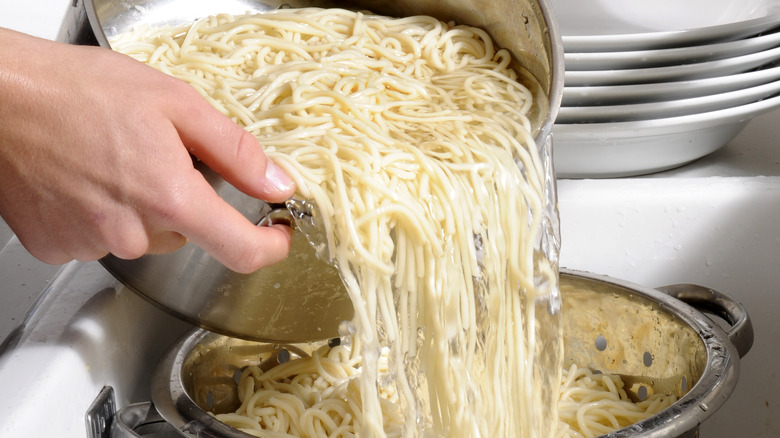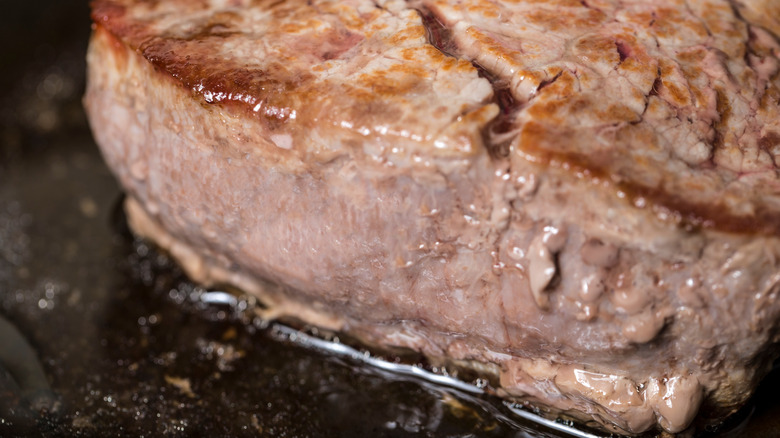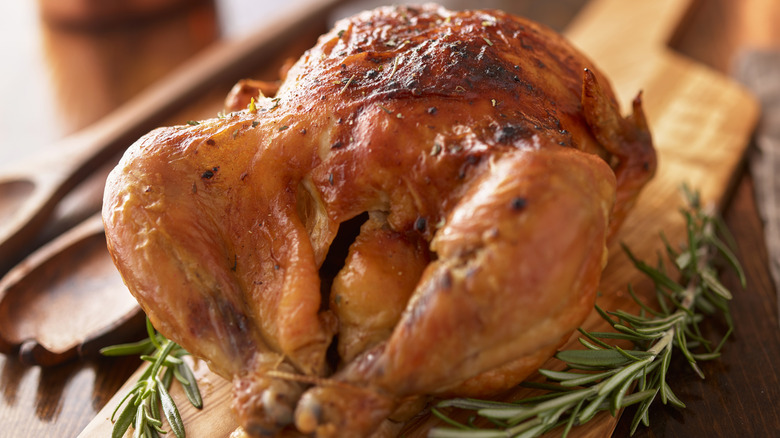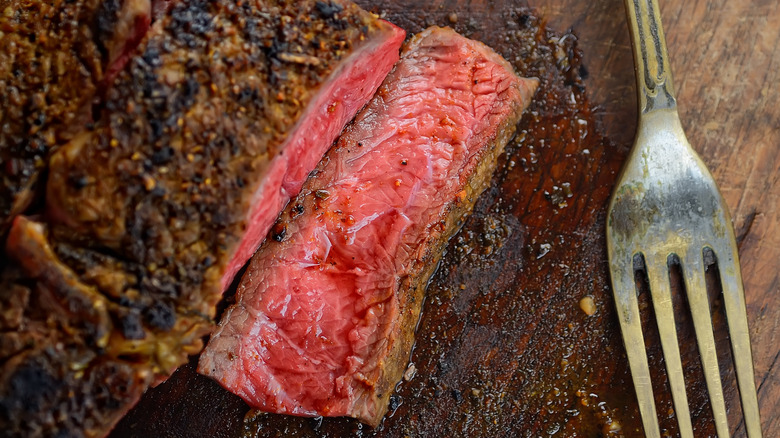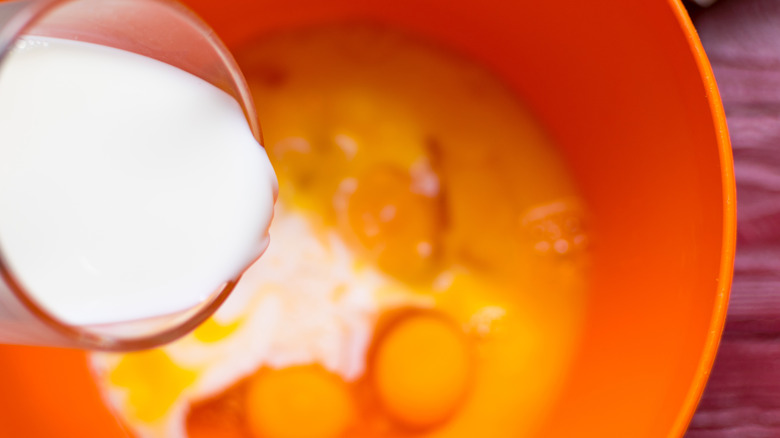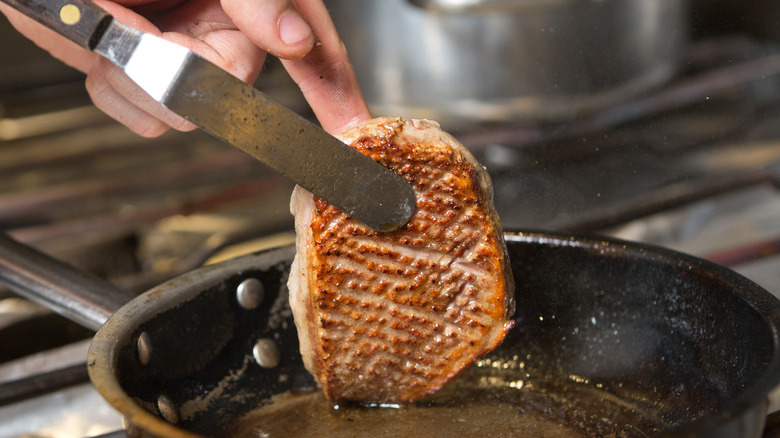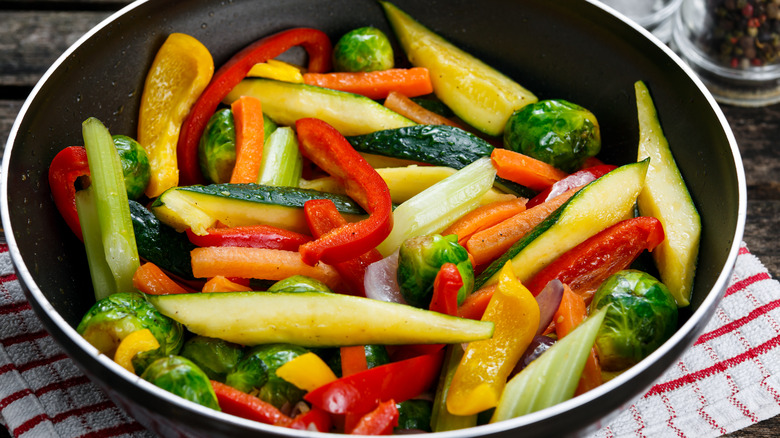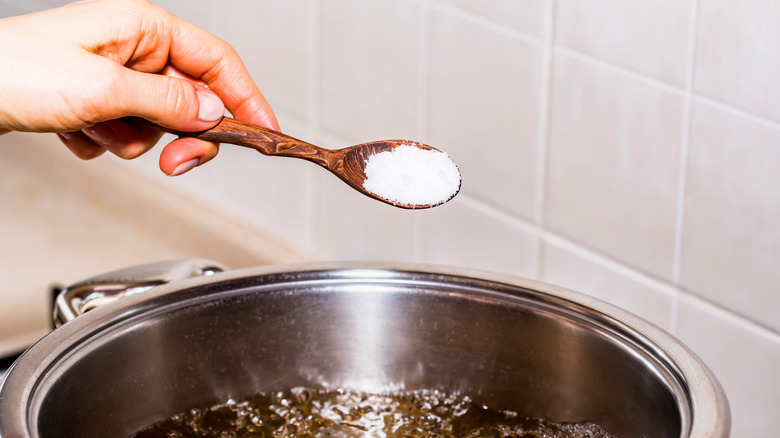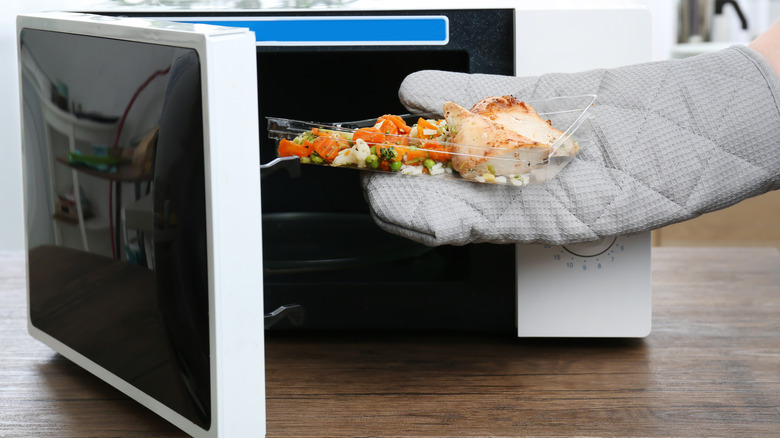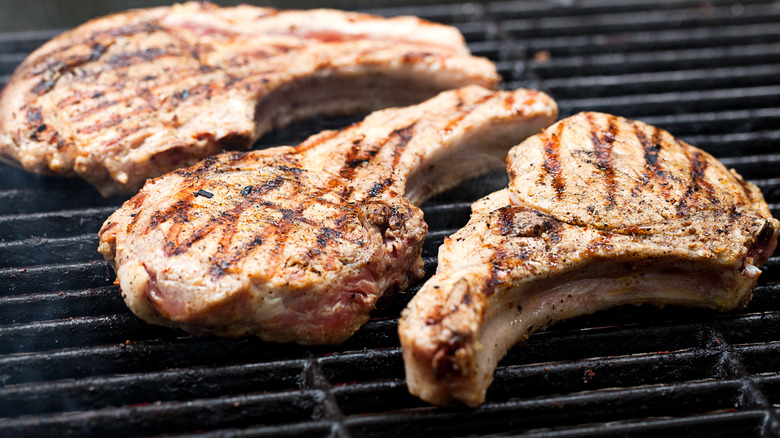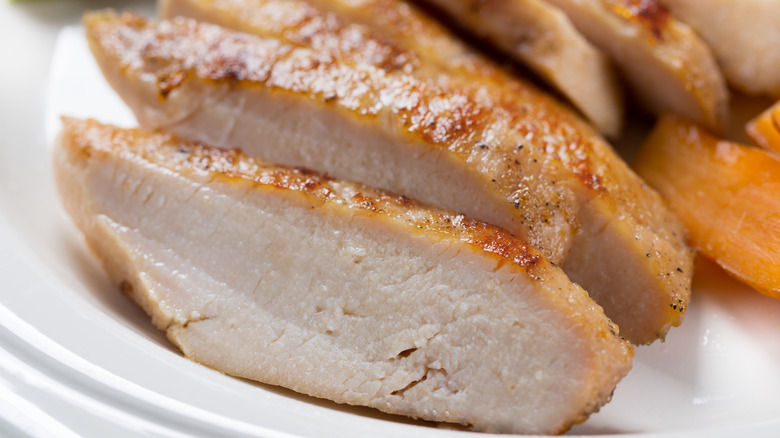Cooking Myths You Should Never Believe
You may already know that lobsters don't scream while they're being boiled (that sound is caused by air trapped in the lobster's shell or stomach) and that serving Thanksgiving turkey won't actually make your guests sleepy (there's no more tryptophan in turkey than other poultry!) but we're willing to bet you've fallen for a common cooking myth or two.
Whether or not you're a novice home cook or a professional chef, sometimes the allure of popular old wives' tales from the kitchen are too strong. There are hundreds of cooking myths out there that masquerade as well-meaning culinary advice — from searing steak to rinsing cooked pasta — but we've rounded up some of the most insistent and pervasive myths that sometimes fool even the most experienced of cooks.
Keep reading to avoid culinary messes or gastronomic frustrations, and to arm yourself with knowledge that will make preparations for your next dinner party (or weeknight family dinner) less of a headache.
Alcohol always burns off
If you've ever served bowls of penne ala vodka or indulged in beer can chicken, you probably have believed this myth. Actually, alcohol does not always burn off completely when cooked with food.
A study published by the USDA found that in cooking various recipes that listed alcohol as a major ingredient, the alcohol retention percentage was more than 40 percent. In the experiment, only a pot roast Milano dish simmered in a pan for two-and-a-half hours burned off approximately 95 percent of the alcohol. A Grand Marnier sauce boiled with hot sauce over a hot flame retained 83-85 percent of its alcohol content.
The highest rates of alcohol retention were for cooking methods where alcohol was briefly boiled over a flame. If you want most of your alcohol to burn off, you'll want to bake it in an oven for at least two hours.
But before you panic about serving last night's wine sauce, to a group of minors, remember that with most recipes, enough of the alcohol will have burned off that you won't actually get drunk.
Pasta should be rinsed
Pasta is one of the easiest foods to make in the world, right? Just boil a pot of water, stick in your a box of rigatoni, wait a little while, and then mix it with your favorite sauce. Actually, there are plenty of ways even a simple pasta dish can go wrong, starting with the all-too common "trick" of rinsing your pasta under cold water.
The reasoning behind this myth is that supposedly when you "shock" the pasta with a good dousing of cold water, it stops the pasta from continuing to cook and preserves its desired al-dente texture.
But that starchy water residue that too often gets rinsed away is actually good for your pasta dish and can help sauce and seasonings stick to the noodles. It also adds a little desired "oomph" to the flavoring and texture. The only time you'll really want to rinse your bowl of pasta in cold water is if you're making a pasta salad to avoid a gummy consistency.
Well-done steak is safer to eat
The next time someone at your table orders their steak "very well-done" in a restaurant and tells you it's for safety reasons, you can tell them that their safe steak order is really just a myth. It's actually perfectly fine to eat your steak with a little pink in it because the amount of harmful bacteria in a cut of meat has been proven to primarily hang out on the outside of the meat. For a typical steak that's cooked to 140 degrees Fahrenheit (or medium temperature), it's very rare that you will get sick. In fact, a study published by the University of Nottingham found that the most bacteria samples collected from cooking slightly pink steak actually came from the cooking utensils, so be sure to sterilize your tongs well!
Just remember that ground beef is slightly different than steak because bacteria can spread from the outside to the inside of the meat when it's passed through a grinder. In this case, when cooking burgers it's safest to cook them to about medium-well or well-done (approximately 160 degrees internal temperature), according to the USDA.
You should remove the skin before cooking chicken
There's nothing quite like gnawing on a tender, barbecued drumstick. But remember when you were a kid and your mom would scold you not to eat the chicken skin because it was fatty/unhealthy and you protested because it was so crispy and delicious? It turns out, mom (and old-school cardiologists) got it wrong this time.
They are right about one thing: Chicken skin is mostly made of fat, but it's the unsaturated kind that you'll find in olive oil and almonds, also known as the kind of fat your body needs to survive and thrive. According to the Harvard School of Public Health, the unsaturated fat in the chicken skin can actually help lower your cholesterol and blood pressure. So the next time someone tries to serve you boneless chicken with the skin removed in the name of health, you can save them a bland meal and improve their cholesterol with this tip.
The red liquid oozing out of your steak is blood
If you've ever watched an adventurous dining companion cut into their rare steak and been disgusted by the juicy red liquid that comes out, you're not alone. But thankfully, that red ooze is not actually blood. (Think about it: You never see that blood red color when you're cooking pork or chicken, right?)
According to the New York Post, that gross red stuff is actually myoglobin: a red-pigmented protein found in muscle tissue. Much like hemoglobin in your blood, myoglobin helps muscle tissue store oxygen. The reason you won't see myoglobin if you eat well-done steak is because as your meat cooks, the myoglobin darkens and looks less blood-like as it reacts to oxygen.
The rosy-red color is appealing to steak connoisseurs, so it's not unusual for meat packers to add carbon monoxide so that the meat does not react with the air and lose that "rare meat" color.
Milk makes fluffier scrambled eggs
Scrambled eggs may be one of the most "basic" breakfast (or anytime) foods out there, but there are still plenty of variations to get the best flavor and texture: How long do you cook the eggs? Do you add butter? When do you add salt and pepper? One of the more popular scrambled egg "tips" is adding a splash of milk to make your eggs come out fluffier. Although this tip sounds plausible (milk is like cream and whipped cream is fluffy!) it's actually not helpful. According to Eat This, Not That adding even a splash of milk to your eggs will just make the egg mixture more runny. Milk also evaporates quicker than the eggs, so it will just leave you susceptible to overcooked scrambled eggs with a rubbery texture, which is definitely not what you want in a perfect breakfast.
The key to real fluffy scrambled eggs is to use low heat and turn it off earlier than you think. Eggs will continue cooking once they're off the flame, so plating them early will help prevent overcooking and give your eggs a nice airy texture. You can also use Dolly Parton's simple trick for perfect scrambled eggs.
Searing meat seals in juices
Here's yet another meat myth busted. If you've ever heard a grilling expert who claims knows how to perfectly sear meat to lock in the juices, you know you're dealing with an amateur. This may be one of the toughest fake cooking tips to shake, but trust us: Searing meat to "lock in juices" by creating an impenetrable barrier does not actually do anything.
In fact, according to an experiment on Serious Eats, cooking a steak on a lower temperature and then finishing off with a sear will actually result in a nice, charred exterior with a juicier interior.
This isn't to say that searing meat is not an important step of the cooking process: It just won't creating a locked "juice barrier." Harold McGee, author of "On Food and Cooking," told Tasting Table that the secret to cooking juicy steak is to make sure the temperature never gets above 140 degrees Fahrenheit so the meat does not dry up.
Cooked vegetables are not as healthy as raw vegetables
Bad news for crudités fans (a fancier way of saying "raw vegetables and dip"): it turns out that despite the pervasive myth, raw vegetables are not inherently more nutritious than their cooked counterparts. As the old wives' tale goes, the vitamins and nutrients in carrots and other root vegetables are burned off as the vegetables are cooked, but thankfully, that's not quite true. Cooking vegetables or eating them raw both have their nutritional trade-offs.
According to The New York Times, water-soluble vitamins like vitamin B or C are diluted when in water, but frozen vegetables actually contain higher levels of vitamin C than fresh vegetables because vitamin C levels degrade during transportation of fresh produce. Fat-soluble compounds like vitamins A, D, E and K are much more likely to "survive" cooking and nutrients like carotenoids in carrots are significantly increased when boiled.
Adding salt makes water boil faster
A watched pot never boils, but adding salt won't help much, unfortunately. Surprisingly, this culinary tall tale is based in fact. According to LiveScience, "less heat is required to increase saltwater's temperature by one degree Celsius than to do the same to freshwater," so technically salty water will boil faster, but you wouldn't really notice a significant difference unless you boil a water solution with 20 percent salt, which would be very salty. To compare, ocean water is about 3.5 percent salt, so pasta boiled in a 20 percent saltwater solution would be inedible, even if the pot of water would boil about 25 percent faster.
Adding a teaspoon or dash of salt to your pot of boiling water won't make any discernible difference in boiling time (even though it will make your pasta taste delicious!) which makes this cooking tip yet another old wives' tale that was based on scientific fact.
Cooking in a microwave removes nutrients
Now that we know that cooking vegetables won't necessarily strip them of their nutrients, it's time to get another related cooking fable out of the way. Although some nutrients naturally break down when exposed to heat, like vitamin C, microwaves are less likely to do so because the cooking times are shorter. With shorter cooking times, you're more likely to preserve the vitamins and minerals naturally found in food.
"The cooking method that best retains nutrients is one that cooks quickly, heats food for the shortest amount of time, and uses as little liquid as possible," according to an article published by Harvard Medical School. "Microwaving meets those criteria."
So, how does this cooking method work? Microwaves steam food from the inside-out by vibrating small amounts of water molecules, which keeps nutrients from burning off. Contrary to the rumors, this proves that microwave-cooking can actually be healthy (even if microwave meals themselves may not be).
Pork needs to be well-done
We now know we don't have to cook steak as long as we thought, but we still have to be super-careful around pork and chicken, right? Even though we may associate partially-cooked pork with scary parasitic infections like trichinosis, the truth is that you don't actually have to cook pork as long as you think you need to in order to kill off any harmful bacteria.
In recent years, cuts of pork have become less marbled, so the longer they are cooked, the drier the meat will turn out (hence why your barbecue pork chops need to be drenched in sauce to taste tender). In 2011, the USDA revised its internal cooking temperature for safe pork consumption to 145 degrees Fahrenheit, but most bacteria will be killed off when the temperature reaches 137 degrees Fahrenheit.
Above all? Trichanella spiralis (or trichinosis) is a parasite that "was historically found in pigs" that "was transferred through eating undercooked meat," but the parasite has been virtually eliminated from the pig population, according to Michigan State University.
Chicken is done when the meat is not pink
Now that we know that pork and steak are not as delicate as we previously thought, it should be reiterated that poultry — including chicken — should still be cooked thoroughly to an internal temperature of 165 degrees Fahrenheit, to avoid bacterial infections.
The traditional way of determining when a piece of chicken breast is thoroughly cooked is to check the color: if it's pink, keep it on the grill. It turns out, that's not the best way to check on a cooked chicken. Even pricking the chicken to make sure that the juices run clear is not a reliable test.
The only sure-fire way to know if your chicken breast is safe to eat is to use a meat thermometer, as the USDA suggests. Oftentimes, when a chicken breast has turned entirely white, it has been overcooked and will taste dry and bland. To keep your chicken juicy, just use the thermometer.
